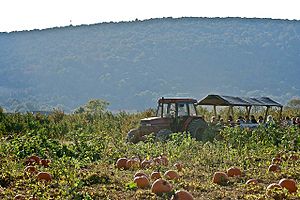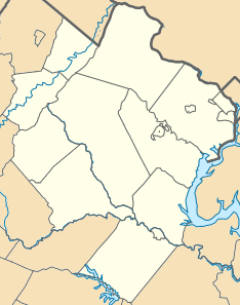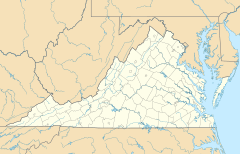Bluemont, Virginia facts for kids
Quick facts for kids
Bluemont, Virginia
|
|
|---|---|
 |
|
| Country | |
| State | |
| County | |
| Elevation | 722 ft (220 m) |
| Time zone | UTC−5 (Eastern (EST)) |
| • Summer (DST) | UTC−4 (EDT) |
| GNIS feature ID | 1492596 |
Bluemont is a small village in Loudoun County, Virginia. It sits at the eastern base of Snickers Gap in the Blue Ridge Mountains. The village is about 4 miles (6.4 km) west of Round Hill.
Bluemont is close to Virginia's fox hunting areas. It is also less than 1 mile (1.6 km) from the famous Appalachian Trail. Nearby are the Bears Den and Raven Rocks formations in the Blue Ridge.
The village was first called Snickersville. It changed its name to Bluemont in 1900. This was done to attract more visitors from Washington, D.C. when a train line was extended to the area. Bluemont is the highest community in Loudoun County, at 700 feet (213 m) above sea level. Each year, in September, Bluemont hosts the Bluemont Fair. This fair is organized by volunteers and started in 1970.
A well-known place nearby is Mount Weather. This is a special facility for the Federal Emergency Management Agency (FEMA). It is used for operations and training in case of emergencies.
Contents
History of Bluemont
Early Settlement and Name Changes
The Bluemont area began to be settled in the 1770s. This happened when new roads connected important travel routes. One road led from Loudoun to Winchester. Another ran from the port of Colchester to Winchester. These new connections made travel much easier.
A small community started to grow where these roads met. It was centered around the home of William Clayton, called Clayton Hall. In 1807, a post office was set up here, and the settlement was named Snickers' Gap.
In 1826, the town was officially recognized as Snickersville. The post office changed its name a few years later. A new turnpike, completed in 1832, brought more growth to the community. During the Civil War, Snickersville saw little fighting. Armies mostly passed through the area.
The Railroad Arrives
In 1875, a railroad line was extended to Round Hill, about four miles east of Snickersville. People wanted to visit the beautiful Blue Ridge Mountains. So, a service began to take travelers from Round Hill to hotels in Snickersville.
By 1900, the resorts near Snickersville were very popular. This led the Southern Railway to extend its tracks all the way to the town. This made Snickersville the final stop on the line. It allowed people to travel by train from Washington, D.C. right to the base of the Blue Ridge.
To make the town sound more like a resort, the railroad asked to change its name. On September 7, 1900, the town was officially renamed Bluemont. The town was at its busiest around 1908, with a population of 200 people.
Decline of Rail Travel and New Beginnings
After 1912, electric trolleys also served Bluemont. However, with the rise of the automobile, fewer people traveled by train. By 1939, parts of the railway were no longer used.
By the 1940s, Bluemont had become a quiet community. Still, its beautiful location attracted people, especially artists and musicians. In 1968, artist Clyde Beck and Evelyn Johnson started the Bluemont Citizens Association. They also began the annual Bluemont Fair. Around the same time, local musicians founded the Bluemont Concert Series.
In 1984, the Bluemont Historic District was added to the National Register of Historic Places. This means it is a special place with important history. Another historic area, the Bear's Den Rural Historic District, was listed in 2008.
The Bluemont ZIP code (20135) is interesting because it covers parts of three different counties. These are Loudoun County, Virginia; Clarke County, Virginia; and Jefferson County, West Virginia.
Bluemont Fair
The Bluemont Fair happens every year on the third weekend in September. It features many fun activities. You can find skilled crafters selling their goods. There are also contests for pickles and pies. A 10K race is held, and there is live music of different kinds. The fair takes place throughout the community, with the main area at the Bluemont Community Center.
The Bluemont Citizens Association sponsors the fair. The money raised helps pay for street lighting, scholarships for local students, and making the community look better. It also helps improve historic buildings and supports local service groups.
Notable People
- Painter William D. Washington was born in Bluemont when it was still called Snickersville.
- Writer Barbara Holland (1933–2010) lived in Bluemont for 20 years. She wrote many of her famous books and essays there.
- Bluegrass Artist Philip Corcoran moved to Bluemont. He recorded a well-known bluegrass version of "Do You Really Want To Hurt Me."
Newspapers
- Purcellville Gazette
In Popular Media
In William R. Forstchen's book series, starting with One Second After (2009), Bluemont becomes an important place. It is shown as the temporary home for the U.S. government after a major emergency.
Climate
Bluemont has a climate with hot, humid summers. The winters are generally mild to cool. This type of weather is called a humid subtropical climate.




